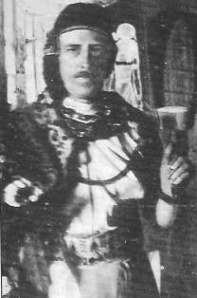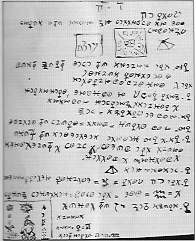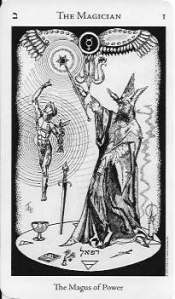English Occult Tarot 1880-1940
 Our secular, multi-cultural world started taking shape in the latter part of the 19th century. Newspapers in Europe and the U.S. displayed ads for astrologers, mesmerists, energy healers and mediums. It was a golden era for occult lodges, when anyone with a robe and a philosophy cherry-picked from Hermeticism, Cabala and the mysterious East could found a lodge and recruit eager followers. The Church was no longer the dominant cultural force; and the emerging scientific worldview was actually good for spiritual seekers. In a secular society the Establishment may think your ritual to invoke the Guardians of the North is foolish or deluded, but the Inquisition won’t haul you in for a date with the Iron Maiden.
Our secular, multi-cultural world started taking shape in the latter part of the 19th century. Newspapers in Europe and the U.S. displayed ads for astrologers, mesmerists, energy healers and mediums. It was a golden era for occult lodges, when anyone with a robe and a philosophy cherry-picked from Hermeticism, Cabala and the mysterious East could found a lodge and recruit eager followers. The Church was no longer the dominant cultural force; and the emerging scientific worldview was actually good for spiritual seekers. In a secular society the Establishment may think your ritual to invoke the Guardians of the North is foolish or deluded, but the Inquisition won’t haul you in for a date with the Iron Maiden.
Until the late 19th Century, Tarot was unknown in the English speaking world except to a few scholars who could read French and had the patience to plow through Eliphas Levi’s turgid tomes. An Englishman who did just that visited Levi in Paris in 1861 and changed the course of history for English occultism and for Tarot. Kenneth MacKenzie returned from his visit inspired to write up a proposal for an occult lodge whose teachings and rituals would be based on MacKenzie’s revisions of Levi’s system. A totally new Tarot deck would be an integral part of the lodge’s teachings. After Mackenzie’s death in 1886, his papers were acquired by two occultists who used his writings to create the Hermetic Order of the Golden Dawn. If Mackenzie’s widow had burned his papers, Anglo-American tarot may have developed along the lines of Etteilla or Wirth. Instead, the Cipher Manuscript changed everything.
 The heart of Mackenzie’s writings were the supposedly ancient Cipher Manuscript and Book T. These manuscripts outlined a new magical order to be called the Golden Dawn, whose teachings were to be based on Levi’s grand synthesis of western esotericism, with some important alterations, and with a greater emphasis on Tarot. Book T spelled out a new set of correspondences between the Tarot trumps, the Hebrew alphabet, pathways on the Tree of Life, and astrology. This system sets Anglo-American esoteric Tarot apart from the continental Tarot traditions of Etteilla, Paul Christian, Eliphas Levi, Wirth and Papus.
The heart of Mackenzie’s writings were the supposedly ancient Cipher Manuscript and Book T. These manuscripts outlined a new magical order to be called the Golden Dawn, whose teachings were to be based on Levi’s grand synthesis of western esotericism, with some important alterations, and with a greater emphasis on Tarot. Book T spelled out a new set of correspondences between the Tarot trumps, the Hebrew alphabet, pathways on the Tree of Life, and astrology. This system sets Anglo-American esoteric Tarot apart from the continental Tarot traditions of Etteilla, Paul Christian, Eliphas Levi, Wirth and Papus.
In 1888, William Westcott and Samuel L. MacGregor Mathers launched the Hermetic Order of the Golden Dawn. This short-lived group attracted artists and intellectuals and became the touchstone for all subsequent magical lodges in the English-speaking world. The Golden Dawn’s complex Tarot teachings included tables of correspondences, use of Tarot in magical workings, and elaborate spreads for divination. The Order “corrected” Levi by assigning the first letter of the Hebrew alphabet to the Fool instead of the Magician, thereby shifting all correspondences to adjacent cards. Then they switched the Strength and Justice cards to make these correspondences more plausible. The Knight became the most powerful court card, the King was demoted and renamed the Prince, and the Pages became Princesses. The ten numbers of the pip cards were associated with the Sephiroth on the tree of life, as in Levi, and were also associated with the 36 decans of the horoscope wheel and the 72 cabalistic angels. The trumps were assigned to the pathways on the Tree of life, and some were given unique designs and names.
The official Golden Dawn tarot deck based on descriptions in Book T was probably drawn by Mathers wife Moina, who had attended art school. Each member of the order was required to make his own hand-drawn copy and to color it according to the Order’s guidelines. Since the deck was part of the Golden Dawn’s secret teachings, it was not distributed to the public and had little influence on Tarot’s evolution. Neophytes who hadn’t produced a hand-colored deck used a Tarot de Marseille. W. B. Yeats owned a deck published by Dotti in Milan.
 Golden Dawn Decks
Golden Dawn Decks
After Israel Regardie diminished the relevance of occult lodges by publishing all of the Golden Dawn’s secret teachings and rituals in the 1930s, including the complete text of Book T, there was no point keeping the deck a secret. In the 1970s, Regardie helped revive the Golden Dawn and worked with members to create decks which will be discussed in the American Occult chapter.
Godfrey Dowson’s Hermetic Tarot was created during a period of seclusion and intense study. This symbolically rich black & white deck follows Book T closely. The accompanying booklet is a good source for background material on the Golden Dawn’s teachings. Gareth Knight, Britain’s most respected contemporary occultist, established his own organization, The Servants of the Light, in 1973. This organization still offers correspondence courses in the Golden Dawn tradition and has produced two decks, The Gareth Knight Tarot designed by Sander Little, and the Servants of the Light Tarot created by the organization’s current head Dolores Ashcroft-Nowicki, with Jo Gill.

 Aleister Crowley’s Thoth Deck
Aleister Crowley’s Thoth Deck
Aleister Crowley (1875-1940) joined the Golden Dawn in 1898 and contributed greatly to the chaos around its dissolution in 1902. This bad boy of the occult devoted his life to sex, drugs and ceremonial Magick. He founded several occult societies, notably the Argentum Astrum in 1908 and Ordo Templo Orientis in 1910.
Crowley’s Thoth deck owes its existence to Lady Freida Harris, wife of a Member of Parliament and a member of one of Crowley’s occult organizations. She urged him to organize his thoughts on Tarot, and between 1938 and 1942 she created oil paintings for each card. The deck has an art deco feel and echoes many early 20th century artistic movements like Futurism, Constructivism, and Rayonism. Each card is designed using Projective Synthetic Geometry as taught by Rudolph Steiner, with geometric lines extending over multiple cards.
The Thoth deck has the Golden Dawn’s Hebrew letter and astrological correspondences on the cards, and the Golden Dawn’s court cards. Crowley renamed Justice, Strength, Temperance and Judgment as Adjustment, Lust, Art and Aeon respectively; and he switched Justice and Strength back to their original Tarot de Marseilles order.
Lady Harris’s oil paintings were displayed in a London gallery in 1942, but a good quality deck was not published until the late 1960s. By this time the Rider Waite Smith deck had sealed its position as the dominant deck in England and America, so the Thoth deck remained in its own niche.
The most influential deck of the 20th century was created by another member of the Golden Dawn. We’ll look at the Rider-Waite-Smith deck on the next page.

